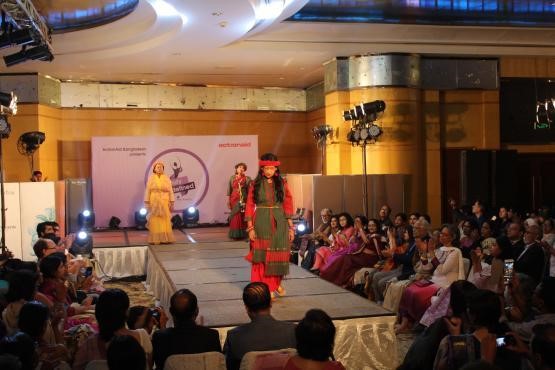

Since joining with ActionAid Bangladesh (AAB) in 2014, I am working on developing the Handloom business as well as handloom sector in Bangladesh. At the time of working with the sector, I gathered a lot of information and data which are hindering the growth of the sector. Nowadays, the sector is declining stage but there is a good prospect of handloom products in our country and outside of our country. The government sector, the private sector and many fascinated individual of Bangladesh are working for the development of the sector but growth is not in significant position.
In the meantime, a renowned fashion designer of Bangladesh, Bibi Russell has come forward to promote handloom products as green products and a heritage of Bangladesh. She chose and used the handloom products from AAB supported Climate Resilience Handloom Factory as dresses of ramp performers of a fashion show. Bibi Russell acted as choreographer where performed 15 acid survivors in the show on 7 March, 2017. They performed in the fashion show in Bangladesh named ‘Beauty Redefined’ the first ever in the world, to show their inner strengths and inner beauty and to stimulate the uses of handloom products.Hundreds of National and International media outlets picked up the story and produced news story.

Historically handloom has got its predominance and heritages in Bangladesh.The tradition of weaving cloth by hand constitutes one of the richest aspects of Bangladesh culture and heritage. The handloom industry in Bangladesh is having a glorious past, questionable present and confusing future. Weavers are suffering from inadequate contemporary technology and scarcity of working capital, which is mandatory to maintain the smooth flow of production (ADB, 2002).
Most of the time, weavers acquire their working capital from their own money and sometimes they acquire capital from various in situations like govt. banks, private banks, and some other financial institutions. According to Handloom Census, 2003 more than 12% handloom units shut down their production due to lack of yarn supply in reasonable price. Weavers in our country don’t get quality raw materials (yarn and dyes & chemicals) at right time and at the right price. Handloom Industry is very important for economic development of Bangladesh, especially in rural areas. Because many villagers are employed in this sector and earn their brads. The world is solely concentrating on ‘green technology’, therefore ‘green production technique’ to save the struggling world, where ‘Handloom technology’ could be best ‘green technology’ to fulfill basic needs of human i.e., clothing, as there is using human labour or artisan for weaving and also not use power engine.
ActionAid Bangladesh (AAB) started working with this handloom sector since 2008 through establishing climate resilience handloom factory in Sirajgonj which area is a business hub of the sector in Bangladesh.
From my working experiences with the sector, it is found that high cost of raw materials, lack of organizing capability, efficiency, lack of policy support, huge knowledge gap, shortage of credit facilities and lack of consumer awareness are the main features of the handloom units operating in Bangladesh.
Poor marketing and insufficient market linkage outside the state ails the industry from growing and earning more revenue. The cost of Handloom products are higher than power loom as it is labour intensive and is not capable of competing with power loom but it can produce the different gorgeous design as per demands of the specific consumers and can create employment opportunities for rural people.
Due to the lower income and instable work, the younger generation of weavers has been migrating to other occupations which are reducing the weaver community.
The role of women in the handloom industry is largely unacknowledged. But this sector derives a majority of its skills and work from women who constitute about 50% of weavers and workers engaged in this sector. Although in some regions, women may not specifically take up weaving work, they are engaged in the production process right from the initial stage of opening up the hank to the finishing of the product.